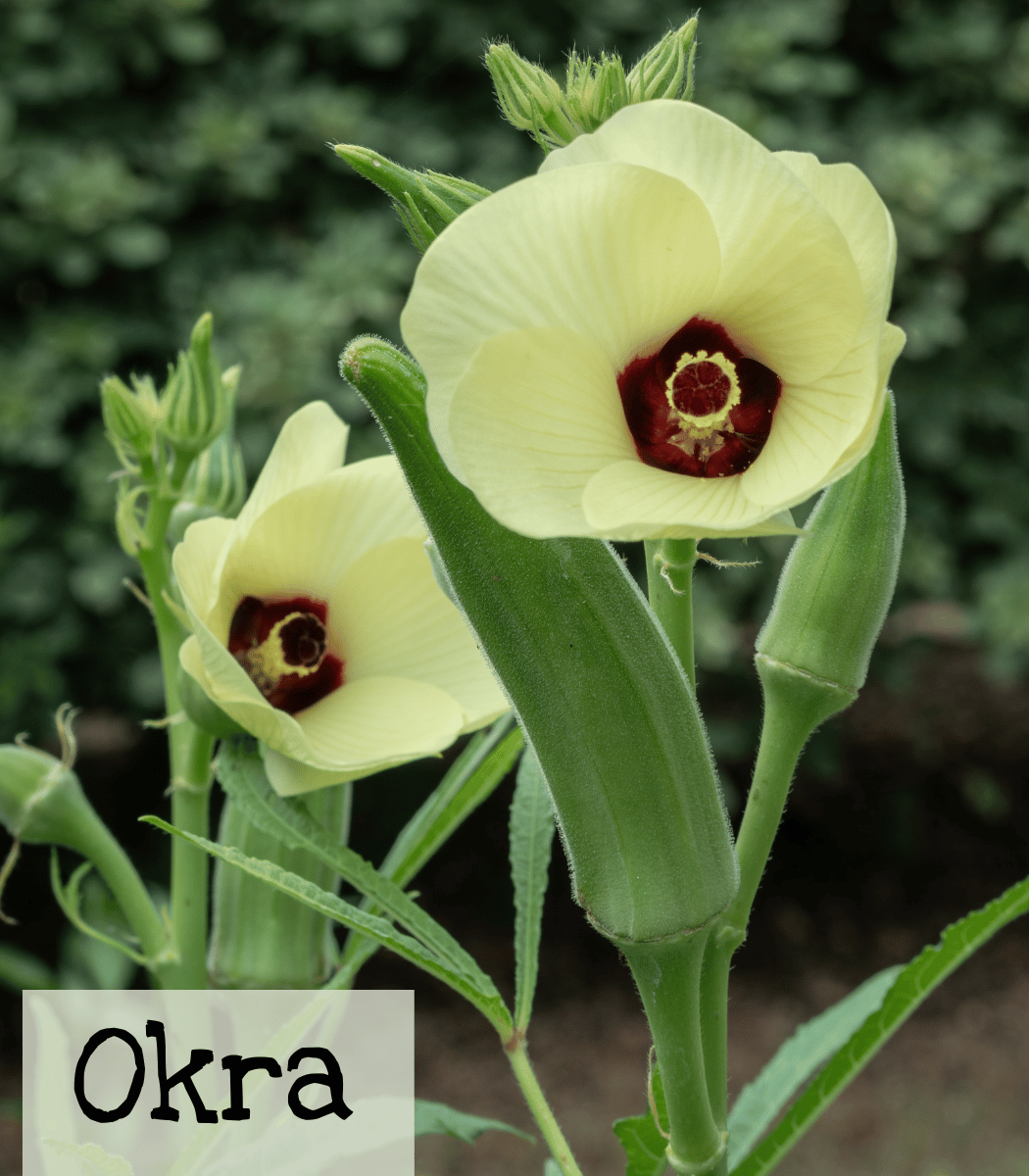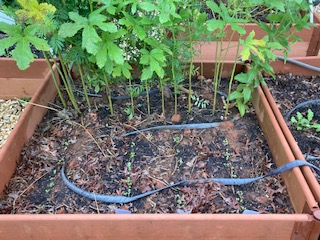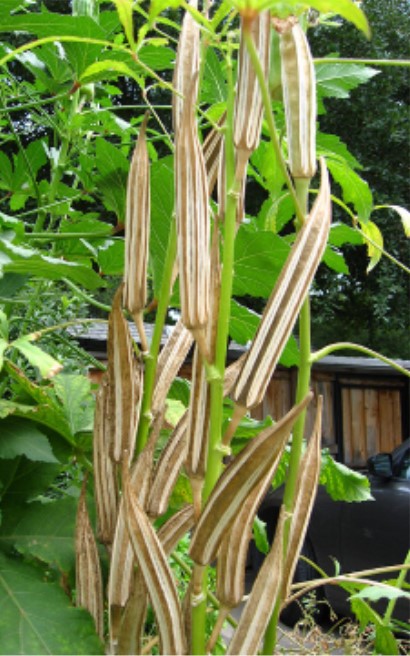
Okra
Related to the hibiscus, the flowers of the okra plant are very beautiful. This heat-loving vegetable originated in Africa.
|
Clemson Spineless; Clemson Spineless 80; Heavy Hitter; Jing Orange |
|
Abelmoschus esculentus |
|
Easy |
|
Easy |
|
4 years if properly stored |
|
Annual |
|
14-21 days |
|
Can be soaked over night |
|
1/2 inch |
|
Clemson Spineless: 3-4′ Clemson Spineless 80: 4′ Heavy Hitter: 5-8′ Jing Orange: 3-4′ |
|
Full Sun |
|
30-60 days |
|
Clemson Spineless: 3” Clemson Spineless 80: 2.5-3” Heavy Hitter: 3-5” Jing Orange: 5-6” |
|
April, May, and June |
|
Yes |

Growing Tips

When to Start
Spring: After the danger of frost has passed.
Fall: Three months before the first frost. (June 15 – July 10 for GA)
How to Start
Direct sow 1/2 inch deep in full sun after the danger of frost has passed. Okra germinates best in soil temperatures ranging from 70-95 F. Many recommend soaking okra seeds overnight, but this isn’t necessary. All it does is speed up germination.
Plant in a deep bed, as okra grows along a tap root. Thin to 6-18 inches depending on how wide/bushy the variety gets.
Care
Okra is a heat-loving plant and tolerant of poor soil and low moisture. Mulch well to retain soil moisture and suppress weeds. Water when the soil is dry or when the plants start to wilt.
Harvest
Harvest when the pods are young as mature pods tend to be woody. See the optimal fruit size above as every variety is a little different as to the best size to pick it. Use scissors to cut the fruit from the stock.
Pest Management
Aphids and Japanese beetles can be a nuisance. Use companion planting to attract the beneficial predators that will eat aphids. For example, alyssum will attract ladybugs and makes an excellent living mulch. Plus it has a wonderful scent! Plant intermixed with the okra and let it spread. For Japanese beetles try planting flowers they enjoy more than okra like marigolds. This is trap cropping.
My personal experience
Okra is a must have in the garden! My favorite way to eat okra is to pan-fry it in a little olive oil and season it with salt and pepper.
It is so easy to grow in the south! I will typicall start mine a litte soon, about the time of the last average frost for my area. Only once have I had to replant do to a late freeze. They will grow to about a foot tall and then stay that tall until the temps warm up. Then they really take off.
Since I start sooner, I don’t soak my seeds overnight. I’m not trying to spead up germination. And they germinate just fine. I’ve tried several different varieites and my favorite so far is clemson spineless. I like how it is less prickly, has excellent flavor, freezes well, and is less slimy than others.
It is best to harvest this varieity at around 3 inches, but if I miss one that’s fine. I let it get mature and brown, then harvest it for seed!

Seed Saving

Isolation Distance
Insect-pollinated okra needs at least ¼ to 1 mile for safe distance isolation. Time isolation is practical for growing two varieties in one season. See tips and tricks for details.
Instructions
Since okra is a long-season plant don’t forget about the neighbors as it may be commonly grown in your area. If planting 2 varieties plant one in spring and the other in fall. Save seeds from the early planting before the late one starts to flower. To safely save seeds from the later planting, at some point pull the early planting, so the flowers aren’t blooming at the same time.
Caging can also be used, but large cages would be needed as plants can be fairly tall (plants planted later in the season would flower before getting as tall as earlier-planted ones). Allow pods to dry on the plants until they begin cracking like in the picture. Then split open to remove seeds and finish drying.

Features
- Drought tolerant
- Culinary
- Clemson Spineless: Fewer prickles, spineless, good flavor, and best pickled when small.
- Clemson Spineless 80: Improved in 1980 by Clemson University to produce more heavily and earlier than regular Clemson Spineless.
- Heavy Hitter: Very productive. It can produce up to 44 pods per day and 250 per season.
- Jing Orange: A favorite of Baker Creek, the pods are bright reddish-orange and flavorful. Drought-tolerant and spineless. Good in stews, stir-fries, and pickled. Chinese heirloom.

-
-
- It is always best to harvest dried seed pods as soon as they are dry. However, if the seed pods do experience light rain they should be okay. Just keep in mind, if the moisture reaches the seeds, viability will be damaged.
- If you want to save seeds from 2 varieties in the same growing season and don’t have a mile to distance them, then isolate them by time.
-
-
- Time isolation can be a bit tricky. What you need to do:
-
- Plant a Spring crop and a Fall crop.
- Before the Fall crop starts flowering, remove the Spring crop. If they flower at the same time there WILL BE cross-pollination.
- Be aware, you may not be able to save seeds from the Spring crop as there may not be enough time for the seeds to mature before the plants need to be removed.
- Some people are allergic to the oils secreted by the leaves of okra plants. If you develop a rash, there is an way to still grow okra. Wear gloves and arm protection when harvesting. Then wash hands and arms with soapy water after harvesting. For many these precautions will be enough, otherwise seek the advice of a doctor.
You May Also Like:
4 Must-Have Flowers for Your Vegetable Garden
Companion Planting: How to use flowers to help control pests.
Trap cropping: How to keep pests out of your main crop.
Sources:
Caes.uga.edu
Gardeningknowhow.com
Staring and Savings Seeds By Julie Thompson Adolf
Edenbrothers.com
